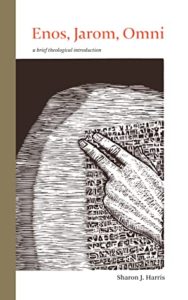 Author: Sharon J. Harris
Author: Sharon J. Harris
Title: Enos, Jarom, Omni: A Brief Theological Introduction
Neal A. Maxwell Institute for Religious Scholarship, 2020. 144p.
Reviewed by Chad Curtis, July 2020
This is my second book review for the Brief Theological Introduction series from the Maxwell Institute, the first being First Nephi. It arrived on my doorstep unannounced last week while my parents were visiting from Utah, and I picked it up whenever I had a few moments to spare. It was a surprising gift; I had previously received a free copy of First Nephi to review as well as a PDF of Second Nephi, but I hadn’t anticipated being considered for more copies in the series. I will have to get myself a copy of Jacob for completeness’s sake.
Sharon Harris has done a stunning job delving into these three short books in the middle of the Book of Mormon (at least as we have it today) which she affectionately refers to as the “flyover books.” She spends some time reflecting on our underappreciation for them, with characterizations I have heard myself in many a Sunday School lesson: they weren’t clearly weren’t as righteous as they weren’t receiving revelation, maybe even in apostasy. Less on the page means less in importance. But Harris quickly turns the tables on you when she considers the similarities to our own day:
Rather than seeing them as a lag or a slowdown in the narrative of spirituality among Lehi and Sariah’s descendants, perhaps we have more in common with them than we realize. It has now been over a century since a revelation was received that was added to the Doctrine and Covenants. Would we say of our day, however, that revelation has ceased? Of course not. In many ways it feels as though revelation continues to increase within the church. But if people 2,500 years from now were to look back, with one narrow selection of records from which to draw their conclusions, would it look as though revelation was booming in the early twenty-first century? Perhaps not.
We do tend to most admire those who get the most real estate on the gold plates in the Book of Mormon. But Harris makes clear that, at best, is a limiting view (after all, only a handful of women make it into the Book of Mormon), at worst, a mis-understanding of who the heroes are in the Book of Mormon (after all, the Nephites were destroyed for the wickedness in the end! Perhaps we should be more critical when modeling our behavior off of them). After reading Harris’s account, I almost want to say that Jarom is my favorite character in the Book of Mormon. I love this characterization of Jarom based on what he chose not to include in his writing:
To prioritize keeping a record that will benefit the Lamanites, Jarom minimizes our view of his spirituality. In other words, he empties himself in the service of the Lamanite descendants… Jarom isn’t the only one in his time who empties himself this way. Many others also keep an eye toward prophesied events instead of a limited and myopic view of their current situation only.
Throughout the book, Harris takes the less-is-more them and runs with it painting within the Book of Mormon space for those who are marginalized. As a gay Mormon, I found this point about lateral (contemporary to contemporary) versus lineal (parent to child) transmission of the Book of Mormon record particularly poignant:
The crossover of lineal and lateral connections across time links all these networks, connecting those who transmit and those who read the record that becomes the Book of Mormon. Because the plates and their story move both ways, they capture all the associated individuals and families not only in a chain but also in chain mail, surrounded by linkages lineally and laterally, stretching in all directions. The chain-mail links include those in less traditional family situations who may not fit neatly into conventional lineal inheritance, such as those who never married, widows and widowers, LGBTQ+ people, those who cannot have children, those who died prematurely, families who are separated, and anyone who cannot care for others. God wants all to be included in the covenantal family.
In such a family-centric church, it can feel that there isn’t a place in the heaven-as-family-reunion envisioned in our doctrine, and finding our own place in the Book of Mormon felt like an extension of grace.
There is something in the way Harris writes that engages you, that makes you want to keep reading. It really was a page turner for me! Combined with fresh doctrinal insights, she plays with common references within the Latter-Day Saint tradition such as primary songs (a chapter heading called geneology: are they doing it?; when talking about living in the messy middle of things, she writes In the metaphoric Great Plains of the pioneers’ trek west, it can seem that all there is to do is walk and walk and walk and walk; ). But I think my favorite reference (it had me laughing!) was a Mormonization of a common aphorism applied to Enos: We might say that Enos is someone you could have a root beer with.
This only touches on the moments in Harris’s book where said “I never thought about it like that!” or stopped to save a passage. This short book is truly a gem.
